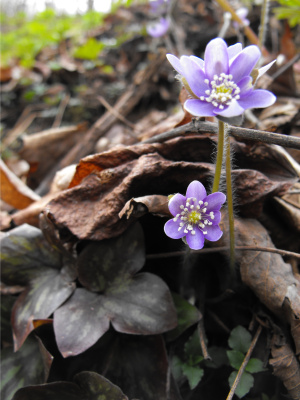
Fertility of understory plants
 So
far, I've been talking mostly about tree leaves, but what about smaller
plants? Jacke
writes that understory plants make up only
about 11% of a forest's biomass, but they contain 37% of the forest's
nitrogen, 29% of its its phosphorus, 33% of its magnesium, and 32% of
its potassium. Clearly, non-woody plants would be my best choice
for fertilizer. I'm already using green comfrey
and grass
leaves
as mulch, but I suspect I should expand this program.
So
far, I've been talking mostly about tree leaves, but what about smaller
plants? Jacke
writes that understory plants make up only
about 11% of a forest's biomass, but they contain 37% of the forest's
nitrogen, 29% of its its phosphorus, 33% of its magnesium, and 32% of
its potassium. Clearly, non-woody plants would be my best choice
for fertilizer. I'm already using green comfrey
and grass
leaves
as mulch, but I suspect I should expand this program.
I was intrigued to read that the understory of a forest can also help
prevent nutrients from washing out of the soil during the winter.
As fallen tree leaves decay, they release soluble nutrients that can
quickly leach away during winter rains. Early spring ephemerals
like bloodroot and hepatica are the only forest plants active at this
time of year, so they are able to suck up the nutrients and use them to
grow leaves and flowers. When the trees leaf out a few weeks
later, the early spring ephemerals die back and rot into
the soil, releasing the same nutrients to be sucked up by hungry tree
roots and complete the cycle. I guess there's a reason other than
beauty (and bees) to add early spring flowers to my forest garden!
| This post is part of our Leaves for Fertility lunchtime series.
Read all of the entries: |
Want more in-depth information? Browse through our books.
Or explore more posts by date or by subject.
About us: Anna Hess and Mark Hamilton spent over a decade living self-sufficiently in the mountains of Virginia before moving north to start over from scratch in the foothills of Ohio. They've experimented with permaculture, no-till gardening, trailersteading, home-based microbusinesses and much more, writing about their adventures in both blogs and books.
Want to be notified when new comments are posted on this page? Click on the RSS button after you add a comment to subscribe to the comment feed, or simply check the box beside "email replies to me" while writing your comment.
